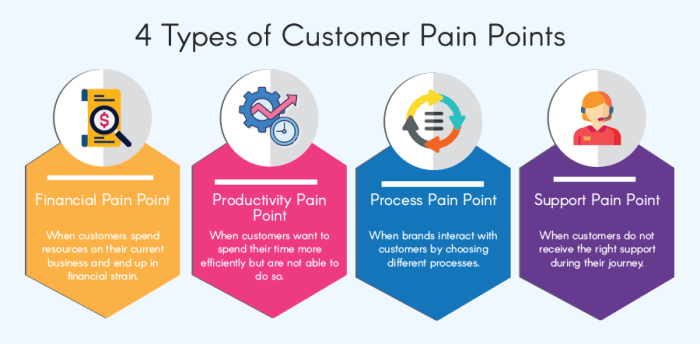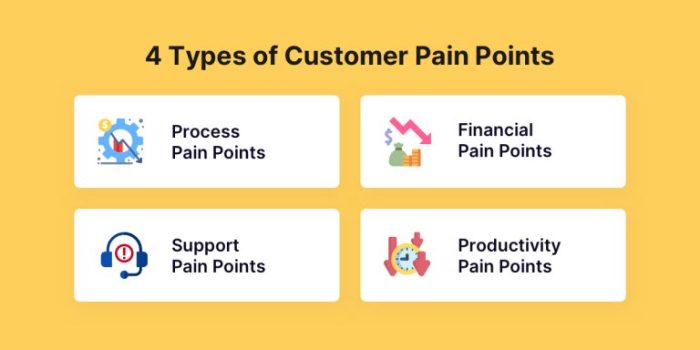Understanding Customer Pain Points dives into the core of consumer experiences, shedding light on the critical factors that drive business success in a fast-paced market landscape. From financial hurdles to logistical nightmares, this exploration uncovers the key elements that can make or break a company’s reputation. Get ready to unravel the secrets behind customer satisfaction and loyalty.
In the realm of business, knowing your customers’ pain points can be the key to unlocking untapped potential and fostering long-lasting relationships.
What are Customer Pain Points?
Customer pain points are specific problems or challenges that customers face when interacting with a product or service. Understanding these pain points is crucial for businesses as it allows them to tailor their offerings to better meet customer needs and improve overall satisfaction. By addressing these pain points, businesses can enhance customer loyalty, increase retention rates, and ultimately drive revenue growth.
Examples of Common Customer Pain Points
- Long wait times in retail stores or restaurants
- Difficulty navigating complex websites or mobile apps
- Poor customer service experiences, such as unresponsive support or rude staff
- High shipping costs or slow delivery times for online purchases
- Lack of product availability or out-of-stock items
Identifying Customer Pain Points
When it comes to identifying customer pain points, there are several methods that can be used to gain valuable insights into what customers are experiencing. These methods include surveys, feedback analysis, and customer interviews.
Surveys
Surveys are a great way to gather quantitative data on customer pain points. By asking specific questions related to their experiences with a product or service, businesses can pinpoint areas of improvement and address issues that customers may be facing.
Feedback Analysis
Analyzing feedback from various sources such as online reviews, social media comments, and customer service interactions can provide valuable information on common pain points. Businesses can use sentiment analysis tools to categorize feedback and identify recurring themes.
Customer Interviews
Directly speaking with customers through interviews or focus groups allows businesses to delve deeper into the emotions and motivations behind their pain points. This qualitative data can provide a more holistic understanding of customer needs and preferences.
Empathy plays a crucial role in identifying and understanding customer pain points. By putting themselves in the shoes of their customers, businesses can develop a deeper sense of compassion and insight into the challenges they face. This emotional connection can lead to more effective solutions and improved customer satisfaction.
Real-Life Examples
- Company A conducted surveys among its customers and found that a common pain point was the difficulty in navigating their website. By redesigning the website with a more user-friendly interface, they were able to improve the overall customer experience.
- Company B analyzed feedback from social media and discovered that customers were dissatisfied with the long wait times for customer service support. As a result, they implemented a live chat feature on their website to provide immediate assistance, addressing the pain point effectively.
- Company C conducted customer interviews and learned that many customers were confused about the pricing structure of their subscription service. By simplifying the pricing options and providing clearer explanations, they were able to reduce customer frustration and increase retention rates.
Types of Customer Pain Points

Customer pain points can vary widely, impacting businesses in different ways depending on the type of pain experienced by customers. Let’s explore the different types of customer pain points and how they can affect businesses.
Financial Pain Points
Financial pain points refer to issues related to the cost of a product or service. Customers may find a product too expensive, or they may feel like they are not getting enough value for their money. Businesses that address financial pain points effectively often offer discounts, payment plans, or loyalty programs to attract and retain customers.
Logistical Pain Points
Logistical pain points involve challenges in the delivery or distribution of products or services. Customers may be frustrated with long shipping times, unclear tracking information, or unreliable delivery services. Businesses can improve customer satisfaction by streamlining their logistics processes, providing accurate tracking information, and offering expedited shipping options.
Technical Pain Points
Technical pain points revolve around issues with a product or service’s functionality or usability. Customers may struggle with complicated user interfaces, frequent software bugs, or inadequate customer support. Businesses can address technical pain points by investing in product development, providing user-friendly interfaces, and offering responsive customer service.
Addressing Customer Pain Points

To effectively address customer pain points, businesses need to listen to their customers, understand their needs, and implement strategies to solve their problems. This involves creating a customer-centric approach that focuses on providing solutions rather than just selling products or services.
Strategies for Addressing Customer Pain Points
- Collect feedback: Regularly gather feedback from customers through surveys, reviews, and customer service interactions to identify pain points.
- Personalize solutions: Tailor your products or services to meet the specific needs of individual customers, addressing their pain points directly.
- Improve communication: Keep customers informed about any changes or updates that address their pain points, showing that you value their feedback.
The Role of Innovation in Resolving Customer Pain Points
Innovation plays a crucial role in resolving customer pain points by introducing new solutions, technologies, or processes that address customer needs in a more efficient or effective way. By continuously innovating, businesses can stay ahead of the competition and provide unique solutions to customer problems.
Case Studies of Successful Businesses
Apple:
Apple identified the customer pain point of complicated user interfaces and developed simple and intuitive products that revolutionized the tech industry.
Amazon:
Amazon addressed the pain point of slow shipping by introducing Prime delivery, offering fast and reliable shipping options to customers.
The Impact of Resolving Customer Pain Points: Understanding Customer Pain Points
Resolving customer pain points can have a significant impact on businesses, leading to increased customer loyalty and satisfaction. By addressing these issues effectively, companies can build stronger relationships with their customers and differentiate themselves from competitors.
Benefits of Resolving Customer Pain Points
- Improved customer retention: When businesses address customer pain points, they are more likely to retain existing customers who appreciate the effort taken to meet their needs.
- Increased customer satisfaction: Resolving pain points leads to happier customers who are more likely to recommend the business to others and make repeat purchases.
- Enhanced brand reputation: Companies that prioritize customer satisfaction by resolving pain points often build a positive reputation in the market, attracting new customers.
Customer Loyalty and Satisfaction, Understanding Customer Pain Points
- Customer loyalty: When businesses consistently address customer pain points, they create a loyal customer base that trusts the brand and is willing to continue doing business with them.
- Customer satisfaction: Resolving pain points shows customers that their concerns are valued, resulting in higher levels of satisfaction and trust in the business.
Examples of Companies Transforming by Addressing Pain Points
- Amazon: By focusing on improving delivery times and customer service, Amazon has transformed into a customer-centric powerhouse that prioritizes resolving customer pain points.
- Apple: Apple’s commitment to creating user-friendly products and providing excellent customer support has helped the company build a loyal customer base that values its dedication to addressing pain points.
- Zappos: Zappos’ emphasis on exceptional customer service and hassle-free shopping experience has set them apart in the online retail industry, leading to increased customer loyalty and satisfaction.
